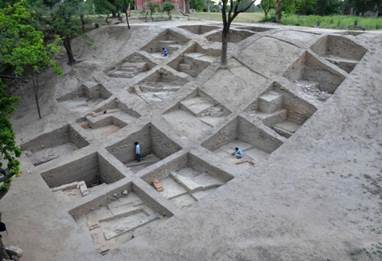Union Minister State for External Affairs and Culture Smt. Meenakashi Lekhi inspects ongoing excavation at Purana Qila,Delhi
Today, Union Minister of State (MoS) for External Affairs and Culture Smt. Meenakashi Lekhi along with delegates of Embassies visited the historic site of Purana Qila in Delhi to inspectthe ongoing excavation work. The site, identified as the ancient city of Indraprastha, has been a subject of archaeological interest for several decades. The excavation has unearthed significant findings, providing insights into Delhi’s continuous history spanning over 2500years.
The event, which coincided with the grand celebration of International Yoga Day, provided a unique opportunity for the visiting delegates to witness, firsthand, the captivating discoveries unearthed through meticulous excavation at Purana Qila.
As one of the most significant archaeological sites in India, Purana Qila holds great historical and cultural importance, and its excavation has been a continuous endeavor to unravel its secrets.
Dr. Vasant Kumar Swarnkar, Director, ASI and the chief excavator overseeing the ongoing excavation at Purana Qila, showcased the remarkable findings to Minister along with a distinguished gathering of delegates, shedding light on the rich heritage and historical significance encapsulated within its walls. He shared valuable insights into the ongoing research, detailing the intricate process of uncovering ancient artifacts, structures,and architectural marvels.
The presentation enabled the Minister and delegates to immerse themselves in the captivating world of ancient civilizations and witness the tangible evidence of human history preserved within the layers of Purana Qila.
Emphasizing the need of using latest technologies, the Minister urged ASI to conduct LIDAR surveys prior to excavation.
Minister along with the delegates was accompanied by Secretary Culture Shri Govind Mohan, Joint Secretary Sanjukta Mudgal, DG ASI KK Basa, Director Northern RegionASI,SADelhi circle along with other officials of Ministry of Culture and ASI.
The ongoing excavation, initiated in January 2023,aims to establish a complete chronologyofthe site. Currently, structures from the early Kushanaleve l have been exposed, with a depth of 5.50 meters reached thus far. This excavation is expected to provide further insights into the ancient city of Indraprastha.
The excavation has yielded are markable collection of artifacts. Notable findings include a stone image of Vaikuntha Vishnu, a terracotta plaque of Gaja Laxmi, a stone image of Ganesha, seals and sealings, coins, terracotta figurines of humans and animals, beads of various stones,T.C.,and abone needle. These artifacts, along with pottery and other antiquities, offer valuable insights into the ancient civilization and trade activities at the site.
The excavation has revealed a continuous existence of human habitation and activities spanning 2500 years, underscoring the historical importance of PuranaQila. More than 136coins and 35 seals and sealings have been discovered from a small excavated area, indicating the site’spivotal role as a center for trade activities.
Furthermore, the excavated remains at Purana Qila will serve as a point of attraction for the delegates of the G20 summit, consisting of Head of States, scheduled to be held in Delhi inSeptember2023.
Purana Qila stands as a testament to India’s rich heritage and cultural diversity, and the ongoing excavation work promises to deepen our understanding of the region’s historical significance. The conservation and preservation efforts, coupled with the establishment of an Open Air Site Museum, will ensure that this historical treasure can be appreciated by present and future generations.
Purana Qila has witnessed multiple excavations in the past. Notably, Padma Shri Prof. B.B. Lal conducted excavations in 1955and 1969-73, followedby excavations led by Dr. Vasant Kumar Swarnkar of the Archaeological Survey of India in 2013-14 and 2017-18. These effortshave revealed nine cultural levels, representing different historical periods, including Pre-Mauryan, Mauryan, Sunga, Kushana, Gupta, PostGupta, Rajput, Sultanate, and Mughal.

